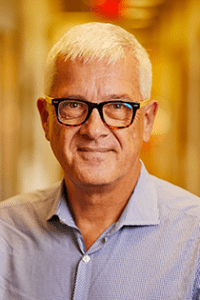By ASHG staff

Shortly after the first cases of the novel coronavirus were reported, human geneticists around the world began to collaborate on investigating the host genetic determinants of COVID-19 susceptibility. Led by Andrea Ganna, PhD, and Mark Daly, PhD, at the Institute of Molecular Medicine, Finland, the COVID-19 Host Genetics Initiative currently has about 160 registered studies and partners.
We sat down with ASHG Past President and NIH Distinguished Investigator Leslie Biesecker, MD, to discuss the efforts at the National Institutes of Health (NIH) in the Initiative.
ASHG: How did you get involved with the COVID-19 initiative?
Dr. Biesecker: Here at NIH, what kickstarted our project was a conversation among colleagues—with Stephen J. Chanock, MD, National Cancer Institute (NCI), and Steven Holland, MD, National Institute of Allergy and Infectious Diseases (NIAID) playing an instrumental role. It was clear early on from clinical reports that there was incredible heterogeneity of COVID-19 disease severity, from asymptomatic patients to those with very severe disease. It was clear that comorbidities were a factor. What was not clear was why young healthy people were also succumbing to this disease. What was happening to these individuals?
ASHG: How did you pivot your research to studying the genetic susceptibility to severe COVID-19 disease?
Dr. Biesecker: Observing that genetics may potentially play a role in COVID-19 susceptibility and talking about this with Steven and Stephen (at NIAID and NCI, respectively), the three of us decided to partner up. My group has a lot of experience in sequencing and doing genetic analyses so we’re in a great position to facilitate the launching of this study rapidly and efficiently.
Often these studies can take a long time to plan and set up but from experience, we know what is practical, ethical, and appropriate to accelerate this through scientific review and the Institutional Review Board at NIH. Our main role is to get this up and running quickly to best serve the public and community. We want to get the genotyping and sequencing data out to the largest community of scientists as fast as possible so that they can get to working on the data and getting answers to these questions in this emergency.
Additional key factors that help our ability to do this rapidly are the nimbleness of the intramural research program and the available resources at the National Human Genome Research Institute (NHGRI). The ability to redirect our own resources towards new problems is much greater than is the case for researchers supported by extramural NIH funding. It is also really supported within the intramural program. It’s a great way to get research started rapidly and begin to tackle a problem before extramural funds can be identified and dispersed. That is an interesting part of how science is organized in this country, what NIH does and why it has both an intramural and extramural component.
ASHG: How are you approaching the problem scientifically?
Dr. Biesecker: We are taking a two-pronged approach by trying to identify common variants using SNP genotyping and GWAS, and genome sequencing to look for rare variants that may be clustering in subsets of individuals. The heterogenous clinical outcomes means that there are likely to be different pathways involved and likely to be a complex genetic architecture.
ASHG: How can data from these studies help in responding to this public health crisis?
Dr. Biesecker: It would be important to be able to stratify patients by risk, especially if we can identify a subset of people who are moderately sick but have very low risk of severe progression. It would be beneficial if we can figure out a way to take care of them outside of the hospital and reduce the burden on the healthcare system. If we can do that, everyone wins—reduce exposure, reduce complications, reduce costs. It is also crucial to understand the pathways involved so that we can identify potential therapeutic targets, especially if it points towards existing compounds that can be quickly repurposed.
ASHG: Have you seen this level of urgency and collaboration amongst the research community before?
Dr. Biesecker: With respect to urgency, it is a little reminiscent of the work that we did when we got involved with victim identification after 9/11. It was on a smaller scale but certainly the urgency and the suddenness of what happened there was similar in that a number of people had to get together and pool their expertise, share methods and data quickly in order to solve an important problem using the tools of genetics. This case is very different, but both are examples of the broad utility of genetics and genomics to answer important questions.
In terms of collaborations, when questions are of highest importance and urgency, people are willing to pitch in, in major efforts. It’s going to happen again and probably at increasing frequency. We will need the infrastructure and ability to respond very rapidly going forward so hopefully we can learn from this current public health crisis. We need to have the system and ability in place and be able to launch it even faster the next time it happens.
